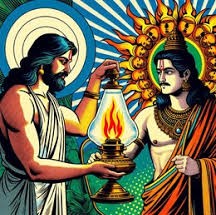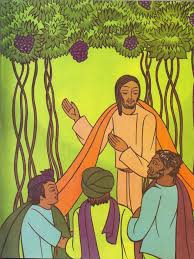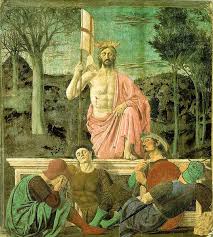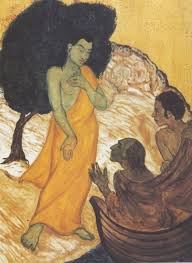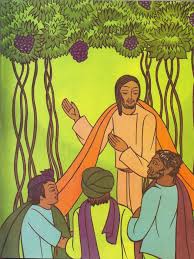[By Rev Fr. Dominic Amalan A]
The Dawn Beyond the Tomb
As the soft hues of dawn kiss the horizon on Easter morning, across the world church bells ring, lilies bloom, and the ancient proclamation resounds: “He is risen!” But Easter is not merely a date on the Christian calendar—it is an experience, a resurrection of the soul, a beckoning toward hope, and a summons to light after long nights of darkness. In the Indian context, Easter offers a deeply relevant spiritual reflection—not just for Christians, but for all seekers of truth across Bharat.
India, a land where nāma smaraṇa (remembrance of the Divine Name) flows through every river and resounds in every temple bell, resonates naturally with the themes of death and rebirth, darkness and light, bondage and liberation. The resurrection of Christ is not alien to Indian philosophy—it is echoed in the Upanishads, which declare: “Asato mā sad gamaya, tamaso mā jyotir gamaya, mṛtyor mā amṛtaṁ gamaya”—”Lead me from untruth to truth, from darkness to light, from death to immortality.”
In a time marked by pandemic aftermath, economic uncertainties, sociopolitical turbulence, and spiritual restlessness, Easter stands as a luminous lighthouse, calling India toward an inner and outer renewal.
The Personal Daily Cross and Rising Again
In every Indian home, whether amidst the verdant coconut groves of Kerala or the bustling lanes of Delhi, individuals are bearing quiet crosses. Be it the struggling mother who fasts so her children may eat, the student facing joblessness, or the elderly yearning for familial connection—resurrection must begin here, at the personal level.
The personal transformation that Easter invites is not unlike the tapasya (austerity) spoken of in Indian spiritual texts. It is the surrender of the ego (ahamkāra), the release of attachments (moha), and the flowering of compassion (karuṇā). Just as Jesus prayed in Gethsemane—“Not my will, but Yours be done” (Luke 22:42)—so too the Indian seeker offers everything at the feet of the Divine, whispering, “tvameva sarvaṁ mama deva deva”—”You are everything, O my God.”
This inner resurrection requires confronting the tombs within: fear, despair, addiction, alienation. It is the embrace of the Cross—sorrow transformed into strength. And here, shānti (peace) emerges not as the absence of suffering, but as the profound presence of the Divine amid suffering.
Philosophical meaning on Dharma, Suffering, and the Empty Tomb
Easter poses an eternal philosophical riddle: How can life emerge from death? How can the Divine die, and yet rise again? These are not foreign to Indian thought. In the Bhagavad Gītā, Sri Krishna declares: “na jāyate mriyate vā kadācin…” – “The soul is never born and never dies.” Likewise, in the Christian tradition, Jesus says, “I am the resurrection and the life” (John 11:25).
Easter challenges the mechanistic view of existence. It affirms a universe that is divya, suffused with purpose, mystery, and grace. The resurrection is not a mere miracle—it is the overturning of entropy, the assertion that love is stronger than death, as Solomon wrote (Song of Songs 8:6).
The tomb, sealed by Roman power and guarded by soldiers, could not contain the light of the world. This echoes the Upanishadic vision of the ātman—hidden, yet undying; veiled, yet victorious. The Easter message shatters nihilism. It declares that behind every crucifixion lies a deeper truth: that suffering is never the end, and that the Divine plan unfolds in compassion.
The Socially Fractured Communities and the Hope of Communion
India today wrestles with its own Good Friday moments. Communal tension, caste discrimination, religious misunderstanding, and social fragmentation mark the landscape. Yet Easter invites a fresh vision—of sangha, of unity beyond difference, of communion over conflict.
Jesus, who dined with sinners, healed the untouchables of his time, and broke social boundaries, stands shoulder to shoulder with every Indian reformer who fought against caste, class, and gender oppression. He is mirrored in the lives of Mahatma Gandhi, B.R. Ambedkar, Mother Teresa, and thousands of unsung sevāks who serve the last and the least.
Easter tells us that division is not destiny. That walls can fall. That resurrection is not just personal but communal. The Body of Christ, broken on Good Friday, becomes the new humanity on Easter—a vasudhaiva kutumbakam, a world family.
The Economics of Bread Broken and Shared Anew
Post-pandemic India finds itself standing at economic crossroads. The rich-poor divide has widened, inflation weighs heavy, and the dreams of youth are deferred. In this economic crucible, Easter offers an ethical paradigm—a model of kenosis, or self-emptying love.
In the Acts of the Apostles, we read that early Christians “shared everything in common” (Acts 2:44). This echoes the Indian ideal of dāna (generosity) and aparigraha (non-possessiveness). An Easter economy is one that values people over profit, compassion over consumption, andlivelihood over luxury.
As India builds smart cities and enters the digital age, let us not forget the grama—the village, the farmer, the artisan. Let our economic resurrection include the weaver of Kanchipuram, the fisherman of Rameswaram, the tea picker of Assam. Easter asks: Can we build an economy of justice, where every table has rice, roti, dal, and every field yields hope?
The Historical Cross in the Indian Landscape
Christianity in India is not a foreign faith—it is among the oldest. St. Thomas the Apostle is believed to have arrived on the shores of Kerala in 52 AD. The Syro-Malabar Church, theGoan Catholic traditions, and the vibrantNagaland and Mizoram churches are living testimonies to an ancient and Indian Christianity.
Yet history has also seen the shadows—colonial entanglements, forced conversions, and sectarianism. Easter invites us to look beyond historical wounds toward historical healing.
Like the purāṇic stories of descent and ascent—of Vishnu taking avatars to restore dharma—so too does the Christian narrative offer an avatāra of love: Jesus descending into the tomb, only to rise and awaken the world.
Let us not trap faith in history’s cage, but allow it to become a force for reconciliation, remembering the words of Christ: “Blessed are the peacemakers” (Matthew 5:9).
The Geographical Horizon of Resurrection in our Bharat
From the passion plays of Goa to the Puthenpaana hymns of Kerala, from the sunrise services in Shillong to the tribal celebrations in Jharkhand, Easter in India is as diverse as her geography. And each celebration tells a story of resurrection amid real-world challenges.
The flooded plains of Bihar, the drought-hit lands of Vidarbha, the insurgency-scarred hills of Manipur—each region awaits its Easter. Not just liturgical, but literal. The tombs are different—poverty, displacement, violence—but the stone remains the same: hopelessness.
Easter calls for a resurrection of land and people alike. It affirms that healing is possible for the wounded terrain of India’s soul. It is the hope that even the most arid desert may one day bloom as the rose.
The Political Communiqué of The Crown of Thorns and the Spirit of Democracy
In a time where democracy grapples with discontent, where dissent is often mistaken for disloyalty, Easter brings forth a potent political message.
Jesus was crucified not just as a religious figure, but as a political threat. He stood against injustice, challenged power with truth, and died with a sign above his head: “King of the Jews” (John 19:19). His resurrection is not a retreat from politics—it is its redemption.
India’s founding fathers—Nehru, Ambedkar, Gandhi—believed in a secularism that was spiritual at heart. Today, in an age of polarization and identity politics, Easter beckons us back to compassionate governance, where the last is made first.
Let us remember that the power that crucifies truth cannot kill it. It may seal the tomb, but truth will roll the stone away.
The Theological Cross paths of the Cosmic Christ and the Indian Spirit
What is Easter, if not the triumph of the satya (truth), the unveiling of the Divine Mystery? Jesus, crucified and risen, is not the property of any one religion. He is, in the words of Sri Ramakrishna, “the ever-living Christ who lives in the hearts of those who love.”
The Cosmic Christ is the Vishwarupa—present in every drop of rain, every cry of the poor, every act of mercy. He is the Prajñā, the divine wisdom that holds all things together. The Cross is not just a Roman gallows—it is the trishūla, the axis of death and rebirth.
In theological terms, Easter is the Mahāpralaya before the Sṛṣṭi—the great dissolution before new creation. The resurrection affirms that grace is stronger than karma, and that God’s love knows no bounds of caste, creed, or custom.
The Risen Light of Bharat
As Easter sunlight filters through church windows and temple domes alike, it illuminates an eternal truth: God is not dead. Love lives. Hope breathes. Resurrection is real.
Let every Indian heart become a living tomb, waiting to be broken open. Let us roll away the stones of hate, ego, division, and despair. Let the rivers of Bharat carry not just silt but also spirit.
In this time of global unrest and national transformation, may we rise—individually, collectively, and spiritually—bearing in our bodies the mark of the Cross, and in our hearts, the echo of the angel’s proclamation: “Why do you seek the living among the dead? He is not here—He is risen.” (Luke 24:5) Allelulia!
This Easter, let’s not just mark a date on the calendar. Let’s take a moment to ask — what do I need to let go of? What do I need to rise into?
Whether you celebrate Easter or not, this season invites all of us to believe in something better — in healing, in justice, in the power of love to bring us back to life.
A Resurrection Song for Bharat
In silence deep where lotus sleeps,
Where Ganga flows and sorrow weeps,
A whisper blooms through midnight’s hush—
The tomb is empty. Feel the rush.
A banyan bends in reverent grace,
The wind remembers every face,
Who wept, who fell, who still believe—
The risen Light no grave can thieve.
From Kanyakumari’s morning skies,
To Himalaya’s ancient cries,
A single flame begins to dance—
The Christ walks here, in every chance.
So lift your hearts, O land of soul,
Break every chain, make broken whole,
Let faith arise, let love redeem,
Let justice flow like Ganga’s stream.
This is our dawn, O land of lore,
The stone is gone, the tomb no more.
Now every heart can truly sing—
Risen is the Eternal King.
Alleluia!
……………………….…………………………………………………………………..
Dominic Amalan A is an author, writer and research scholar exploring the intersections of faith, justice, and identity in contemporary India. The views expressed are personal.


